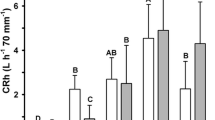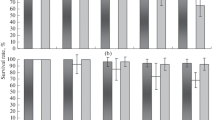Abstract
The effects of fluctuating salinities on the survival and activity of Urosalpinx cinerea (Say) from the James River, Virginia, USA, were observed and compared to results of similar studies at constant salinities. All experiments were conducted at summer temperatures. The lower extremes of salinity fluctuations, especially values below 9‰, had the greatest effect on mortality; the upper extremes may have delayed, but did not reduce, mortality. There was a characteristic 10-day mortality-free period at the start of the fluctuating salinity experiments. Mortality patterns were much different in constant salinities, where the first 2 weeks of exposure were characterized by highest mortalities. In both types of experiments, drill activity, measured by attachment, feeding, and oviposition, increased as salinities increased above lethal levels (greater than a minimum of 9‰). Fluctuating salinities, which approximated field conditions, affected drills differently from constant salinities and were, therefore, more realistic for study of these estuarine organisms.
Similar content being viewed by others
Literature Cited
Carriker, M. R.: Seasonal vertical movements of oyster drills. Proc. natn. Shellfish. Ass. 45, 190–198 (1954).
—: Critical review of the biology and control of oyster drills Urosalpinx and Eupleura. Spec. scient. Rep. U.S. Fish Wildl. Serv. (Fish.) No. 148, 1–150 (1955).
Cole, H. A.: The American whelk tingle Urosalpinx cinerea (Say), on British oyster beds. J. mar. biol. Ass. U.K. 25, 477–508 (1942).
Engle, J. B.: Preliminary report of the U.S. Bureau of Fisheries oyster drill control project in New Jersey, 1935–1936, Rep. U.S. Commnr Fish. (1935–1936). (Unpublished).
Engle, J. B.: Effect of Delaware River Flow on oysters in the natural seed beds of Delaware Bay. Rep. Dir. Fish Wildl. Serv. 1–28 (1953). (Limited distribution).
Federighi, H.: Studies on the oyster drill (Urosalpinx cinerea Say). Bull. Bur. Fish., Wash. 47, 83–115 (1931).
Franz, D. R.: Some studies on physical variation among populations of the oyster drill Urosalpinx cinerea. Proc. natn. Shellfish. Ass. 56 (3) (Abstract only). (1965).
Franz, D. R.: Further studies on physical variation among population of oyster drills. Proc. natn. Shellfish. Ass. 57 (2) (Abstract only). (1967).
Galtsoff, P. A., H. F. Prytherch and J. B. Engle: Natural history and methods of controlling the common oyster drills (Urosalpinx cinerea Say and Eupleura caudata Say). Circ. Bur. Sport Fish. Wildl. 25, 1–24 (1937).
Glaney, J. B.: Oyster production and oyster drill control. Conv. Pap. natn. Shellfish. Ass. New Orleans, La. (1953).
Hargis, W. J. Jr.: A rapid live-sexing technique for Urosalpinx cinerea and Eupleura caudata, with notes on previous methods. Limnol. Oceanogr. 2, 41–42 (1957).
Haskin, H. H.: Investigations on the boring and reproduction activities of oyster drills Urosalpinx cinerea Say and Eupleura sp. Rep. U.S. Commnr Fish. (1935). (Unpublished).
Haven, D. S. and J. Whitcomb: Results of oyster drill studies in 1965 in the James River, Virginia; with notes on laboratory experiments in constant salinities. Rep. Va Inst. mar. Sci. (Unpublished).
Manzi, J. J.: Combined effects of salinity and temperature on the feeding and survival rates of Eupleura caudata (Say) and Urosalpinx cinerea (Say) (Prosobranchia: Muricidae) Biol. Bull. mar. biol. Lab., Woods Hole 138, 35–46 (1970).
Nelson, T. C.: The oyster drill: a brief account of their life history and possible means of combating them. Appendix Rep. biol. New Jers. St. Bd Shellfish., Nov., 1922.
Sizer, I. W.: Observations on the oyster drill with special reference to its movement and to the permeability of its egg case membrane. Rep. U.S. Commnr Fish. (1936). (Unpublished).
Stauber, L. A.: Ecological studies on the oyster drill Urosalpinx cinerea in Delaware Bay, with notes on the associated drill, Eupleura and with special consideration of control methods. Oyster Research Laboratory, Rutgers University, New Brunswick, N.J. 180 pp. (1943).
—: The problem of physiological species with special reference to oysters and oyster drills. Ecology 31, 109–118 (1950).
Wood, L. A.: Effects of river flow regulation by Salem Church Dam on marine organisms. Rep. Bur. Sport Fish. Wildl. U.S. Fish Wildl. Serv. by Salem Church Dam Study Comm. Va Inst. mar. Sci., J.D. Andrews, Chmn, 16 pp. (1964). (Unpublished).
Author information
Authors and Affiliations
Additional information
Communicated by J. Bunt, Miami
Contribution No. 543, Virginia Institute of Marine Science, submitted by the senior author to the School of Marine Science of the College of Williams and Mary, in partial fulfillment of the requirements for the Master of Arts degree.
Rights and permissions
About this article
Cite this article
Zachary, A., Haven, D.S. Survival and activity of the oyster drill Urosalpinx cinerea under conditions of fluctuating salinity. Marine Biology 22, 45–52 (1973). https://doi.org/10.1007/BF00388909
Accepted:
Issue Date:
DOI: https://doi.org/10.1007/BF00388909




